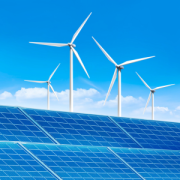Energy supply in Germany is in transition. And nowhere has the pressure to transform been as visible as at LEAG in Lusatia, Germany. Until recently, energy from LEAG (the country’s second-largest electricity producer) was almost exclusively sourced from lignite. But in 2019, the government decided that Germany would phase out coal by the end of 2038 at the latest — LEAG faced a slow but steady demise.
When I started as LEAG‘s CEO at the beginning of 2022, I was immediately excited by the potential of the traditional eastern German company with its 7,000 employees. It quickly became apparent there was only one chance for the company to continue playing a key role in Germany’s future energy supply: LEAG must go green.
We believe the inevitable end of conventional fossil fuel energy must be followed by a complete transition to renewable energy, with a focus on wind and photovoltaic (PV).
Introducing GWF
By 2040, LEAG plans to produce up to 14 gigawatts of PV and wind energy, build H2-ready power plants with more than 4 gigawatts of output, have 3 gigawatt hours of storage capacity in batteries, and make electrolysis power available. This will create a high-quality, green energy pool of 20 gigawatts.
We named the project GigawattFactory (GWF) because it is unique in Europe in its size and concentration of renewable onshore energy. We plan to invest up to €10 billion by 2030 (about US $11 billion) with the goal of delivering high-quality green energy on an industrial scale.
With large battery storage and electrolysis plants to produce green hydrogen, GWF will generate clean energy that can be used regardless of the season, weather, or time of day. This means baseload green electricity in new amounts and without lags or lulls. Hydrogen-capable gas power plants or pure hydrogen power plants are scheduled to go online by the end of the decade. Documents have been submitted for approval for a large part of these systems, so when important framework conditions (e.g., the power plant concept and electricity market design) are finalized by the government, we can get started.
The new power plants will be built at our existing lignite power plant locations so they can leverage infrastructure already in place, including transmission grid connections. Connection to the gas or hydrogen network in eastern Germany, which has yet to be built, is in the early planning stages. It will also be possible to use the green hydrogen produced for sector coupling for things like municipal public transport or district heating.
GWF combines large amounts of green electricity, storage options, and sector coupling to create a comprehensive, efficient green energy system for an entire region and far beyond. As Lusatia becomes a green energy powerhouse, it can carve out a unique position in Germany and Europe, becoming Europe’s special green energy zone.
However, even with a convincing vision and favorable conditions, there are challenging years ahead. The project is complex, ambitious, and dependent on navigating our way through many regulations and external factors, including political decisions. All this takes place during a time of economic strain, tense discussions about secure energy supply, questions about the right energy policy for the future, and the comprehensive transformation of the German energy industry. That’s why we need broad support from lawmakers, our workforce, and the general population.
[For more from the author on this topic, see: “Blueprint for Germany’s Energy Transition: Think Big, Think Green.”]



